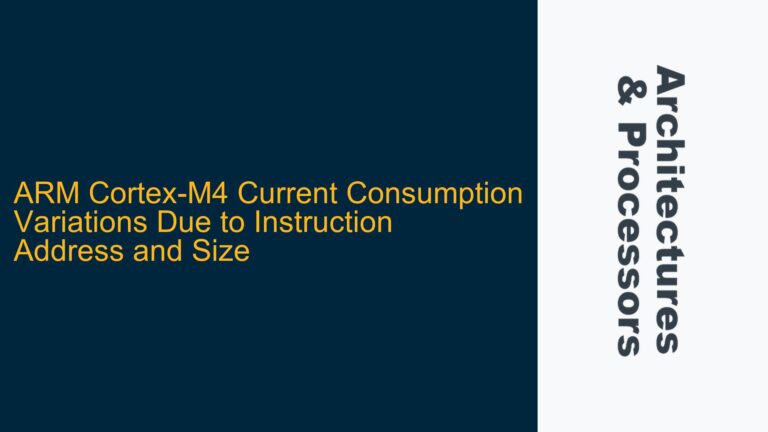APB5 Parity Bit Generation and Timing Constraints
The Advanced Peripheral Bus (APB) is a part of the ARM Advanced Microcontroller Bus Architecture (AMBA) and is widely used in low-bandwidth, low-power peripheral interfaces. APB5, the latest version of the APB protocol, introduces several enhancements, including parity checking for error detection. Parity checking is a simple yet effective method for detecting errors in data transmission. However, the APB5 specification mentions a limitation related to the generation of parity bits, specifically that the parity check assumes three logic levels are available in the timing allowance for generating each parity bit. This limitation is critical for ensuring that the parity bit can be calculated and validated within the timing constraints of the bus.
The three logic levels refer to the combinatorial logic required to calculate the parity bit for an 8-bit signal. The parity bit is a single bit that is added to the data to make the number of 1s in the data either even (even parity) or odd (odd parity). The calculation of this parity bit must be done quickly enough to fit within the timing budget of the APB5 protocol. If the combinatorial logic required to calculate the parity bit is too deep (i.e., has too many levels), it could exceed the timing budget, leading to timing violations and potential data corruption.
The timing budget for the APB5 protocol is determined by the setup time, hold time, and propagation delay of the signals. Setup time is the time required for the data to be stable before the clock edge, hold time is the time required for the data to remain stable after the clock edge, and propagation delay is the time it takes for a signal to travel from the source to the destination. The parity bit must be calculated and validated within these timing constraints to ensure reliable data transmission.
Combinatorial Logic Depth and Parity Calculation
The three logic levels mentioned in the APB5 specification refer to the depth of the combinatorial logic required to calculate the parity bit for an 8-bit signal. Combinatorial logic is a type of digital logic where the output is a pure function of the present input only. In the context of parity bit generation, the combinatorial logic is used to XOR (exclusive OR) the bits of the data to produce the parity bit.
For an 8-bit signal, the parity bit can be calculated using a tree of XOR gates. The first level of the tree XORs pairs of bits, the second level XORs the results of the first level, and the third level XORs the results of the second level to produce the final parity bit. This structure ensures that the parity bit can be calculated with a minimal number of logic levels, which is critical for meeting the timing constraints of the APB5 protocol.
The following table illustrates the XOR tree structure for calculating the parity bit of an 8-bit signal:
| Logic Level | Operation | Input Bits | Output |
|---|---|---|---|
| Level 1 | XOR | Bit 0, Bit 1 | Result 1 |
| Level 1 | XOR | Bit 2, Bit 3 | Result 2 |
| Level 1 | XOR | Bit 4, Bit 5 | Result 3 |
| Level 1 | XOR | Bit 6, Bit 7 | Result 4 |
| Level 2 | XOR | Result 1, Result 2 | Result 5 |
| Level 2 | XOR | Result 3, Result 4 | Result 6 |
| Level 3 | XOR | Result 5, Result 6 | Parity Bit |
This structure ensures that the parity bit can be calculated with only three levels of combinatorial logic, which is within the timing budget of the APB5 protocol. If the combinatorial logic were deeper (i.e., had more levels), the propagation delay would increase, potentially exceeding the timing budget and causing timing violations.
Implementing Parity Bit Generation with Minimal Logic Levels
To ensure that the parity bit generation meets the timing constraints of the APB5 protocol, it is essential to implement the combinatorial logic with the minimal number of levels. This can be achieved by carefully designing the XOR tree structure and optimizing the logic gates to minimize propagation delay.
The first step in implementing the parity bit generation is to design the XOR tree structure. As shown in the table above, the XOR tree consists of three levels of XOR gates. The first level XORs pairs of bits, the second level XORs the results of the first level, and the third level XORs the results of the second level to produce the final parity bit. This structure ensures that the parity bit can be calculated with only three levels of combinatorial logic.
The next step is to optimize the logic gates to minimize propagation delay. This can be achieved by using high-speed logic gates and minimizing the length of the signal paths. High-speed logic gates have a lower propagation delay, which helps to ensure that the parity bit can be calculated within the timing budget. Minimizing the length of the signal paths reduces the time it takes for the signals to travel from the source to the destination, further reducing the propagation delay.
In addition to optimizing the logic gates, it is also important to consider the layout of the logic gates on the chip. The layout should be designed to minimize the distance between the logic gates, reducing the length of the signal paths and further minimizing the propagation delay. This can be achieved by placing the logic gates close together and using short, direct connections between them.
Finally, it is important to verify that the parity bit generation meets the timing constraints of the APB5 protocol. This can be done using timing analysis tools, which simulate the propagation delay of the signals and verify that the parity bit can be calculated within the timing budget. If the timing analysis reveals that the propagation delay exceeds the timing budget, further optimization of the logic gates and layout may be required.
In conclusion, the three logic levels mentioned in the APB5 specification refer to the depth of the combinatorial logic required to calculate the parity bit for an 8-bit signal. By carefully designing the XOR tree structure and optimizing the logic gates and layout, it is possible to implement the parity bit generation with the minimal number of logic levels, ensuring that it meets the timing constraints of the APB5 protocol. This is critical for ensuring reliable data transmission and preventing timing violations that could lead to data corruption.






